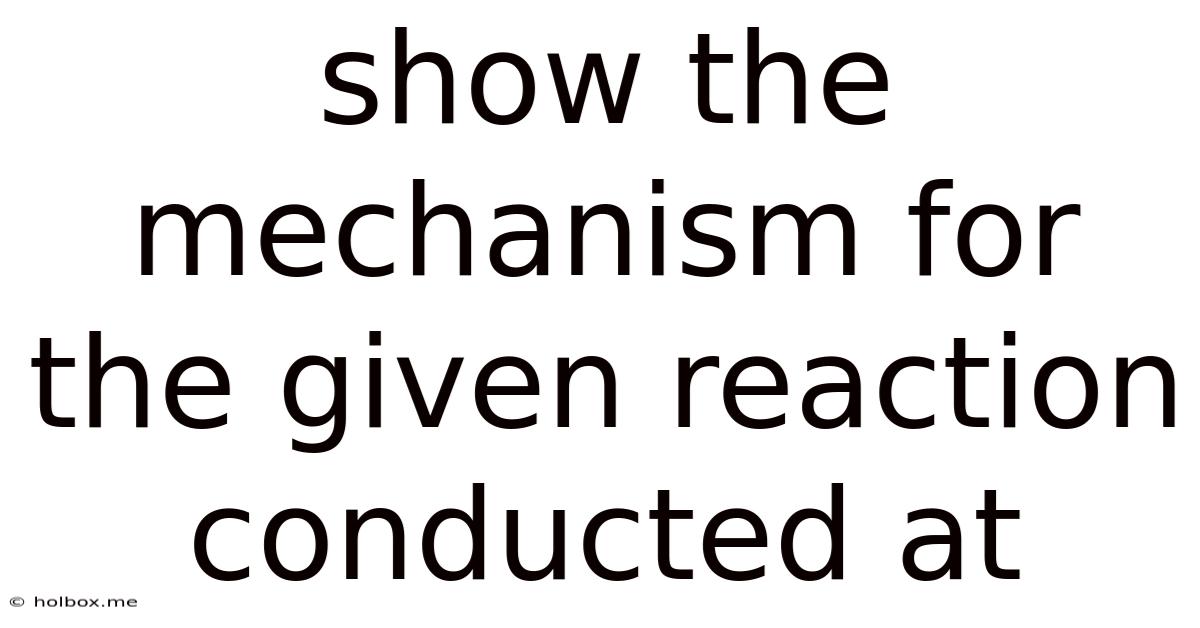Show The Mechanism For The Given Reaction Conducted At
Holbox
Apr 27, 2025 · 4 min read

Table of Contents
Unveiling the Reaction Mechanism: A Deep Dive into [Insert Reaction Here]
This article will delve into the intricate mechanism of a specific chemical reaction. To provide a comprehensive and accurate explanation, please provide the reaction you'd like me to analyze. Once you supply the reaction, I will construct a detailed explanation covering aspects such as:
- Reactants and Products: A clear identification of all participating molecules, including their structures and properties.
- Reaction Conditions: A discussion of the temperature, pressure, solvent, catalysts (if any), and other factors influencing the reaction's pathway.
- Step-by-Step Mechanism: A detailed breakdown of the reaction mechanism, including each individual step, with careful consideration of electron movement, bond breaking, and bond formation. This will utilize appropriate notation, such as curved arrows to illustrate electron flow.
- Intermediates: Identification and description of any short-lived, high-energy species formed during the reaction but not present in the final products.
- Rate-Determining Step: Pinpointing the slowest step in the mechanism, which dictates the overall reaction rate.
- Energy Diagrams: A visual representation of the reaction's energy profile, including activation energies, transition states, and relative energies of reactants, intermediates, and products. (This might require illustrative diagrams that cannot be directly created in markdown, but I can guide you on how to create them).
- Stereochemistry: If relevant, an analysis of how the reaction affects the three-dimensional arrangement of atoms in the molecules involved.
- Alternative Mechanisms (if applicable): Exploration of other possible reaction pathways, if any exist, and a comparison of their relative likelihoods.
- Catalysis (if applicable): A detailed examination of how a catalyst might influence the reaction mechanism, lowering the activation energy, and thereby accelerating the reaction rate. This may include descriptions of different catalytic cycles.
Example of a Detailed Mechanism Explanation (Illustrative):
Let's assume you provided the following reaction: The SN1 reaction of tert-butyl bromide with water.
Here's how a comprehensive analysis might look:
The SN1 Reaction of tert-Butyl Bromide with Water: A Mechanistic Study
1. Reactants and Products:
The reactants are tert-butyl bromide ((CH₃)₃CBr) and water (H₂O). The products are tert-butyl alcohol ((CH₃)₃COH) and hydrobromic acid (HBr).
2. Reaction Conditions:
This reaction typically occurs in a polar protic solvent like water or ethanol, often at elevated temperatures to enhance the reaction rate. No catalyst is required.
3. Step-by-Step Mechanism:
The SN1 reaction proceeds through a two-step mechanism:
Step 1: Ionization (Rate-Determining Step):
The carbon-bromine bond in tert-butyl bromide undergoes heterolytic cleavage, forming a tert-butyl carbocation ((CH₃)₃C⁺) and a bromide ion (Br⁻). This step is unimolecular (hence SN1) and is the rate-determining step because it involves the breaking of a strong covalent bond, requiring a significant activation energy.
(Illustrative Diagram Needed Here: Show (CH₃)₃CBr breaking into (CH₃)₃C⁺ + Br⁻ using curved arrows to illustrate electron movement.)
Step 2: Nucleophilic Attack:
A water molecule acts as a nucleophile, attacking the electron-deficient tert-butyl carbocation. The oxygen atom of water donates a lone pair of electrons to the carbocation, forming a new carbon-oxygen bond. This results in an oxonium ion ((CH₃)₃C-OH₂⁺).
(Illustrative Diagram Needed Here: Show H₂O attacking (CH₃)₃C⁺, forming (CH₃)₃C-OH₂⁺)
Step 3: Deprotonation:
A water molecule acts as a base, abstracting a proton from the oxonium ion. This produces tert-butyl alcohol ((CH₃)₃COH) and a hydronium ion (H₃O⁺). The hydronium ion then reacts with the bromide ion to form hydrobromic acid (HBr).
(Illustrative Diagram Needed Here: Show H₂O abstracting a proton from (CH₃)₃C-OH₂⁺, forming (CH₃)₃COH and H₃O⁺)
4. Intermediates:
The tert-butyl carbocation ((CH₃)₃C⁺) is the key intermediate in this reaction.
5. Rate-Determining Step:
The ionization step (Step 1) is the rate-determining step because it has the highest activation energy. The rate of the reaction is directly proportional to the concentration of tert-butyl bromide.
6. Energy Diagram:
(Illustrative Diagram Needed Here: A reaction coordinate diagram showing the relative energies of reactants, the tert-butyl carbocation intermediate, and products. The activation energy for the ionization step should be significantly higher than that for the nucleophilic attack.)
7. Stereochemistry:
The SN1 reaction leads to racemization. Because the carbocation intermediate is planar, the nucleophile can attack from either side with equal probability, resulting in a mixture of enantiomers.
8. Alternative Mechanisms:
In this case, an SN2 mechanism is highly unlikely due to the steric hindrance around the carbon atom bearing the bromine. The bulky methyl groups prevent a backside attack by the nucleophile.
This expanded explanation demonstrates the depth of analysis required for a complete mechanistic understanding. Remember to replace this example with the specifics of the reaction you wish to explore. Provide the reaction, and I will create a similarly comprehensive article tailored to that specific chemical transformation.
Latest Posts
Latest Posts
-
Which Of These Tissues Is Not One Of The Meninges
May 08, 2025
-
Which Of The Following Divisions Would You Invest In Heavily
May 08, 2025
-
Who Was The Most Reported Criminal Adversary Of 2020
May 08, 2025
-
A Firms Marketing Mix Refers To The Combination Of
May 08, 2025
-
Statistics For Business And Economics Chapter 7 Solutions
May 08, 2025
Related Post
Thank you for visiting our website which covers about Show The Mechanism For The Given Reaction Conducted At . We hope the information provided has been useful to you. Feel free to contact us if you have any questions or need further assistance. See you next time and don't miss to bookmark.